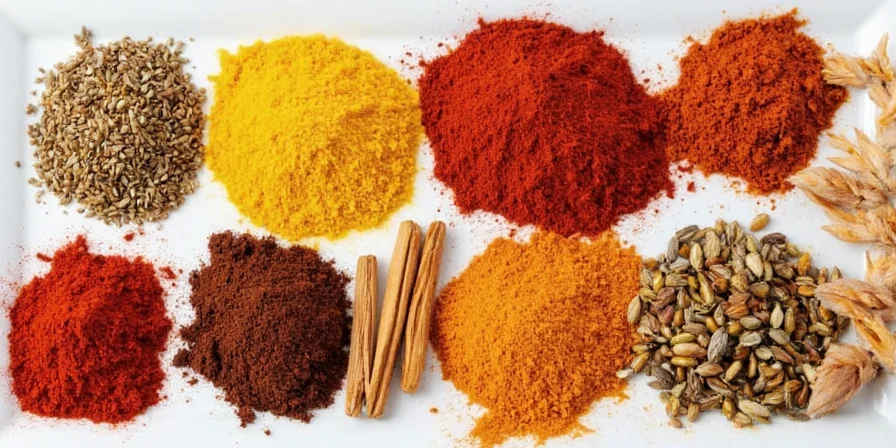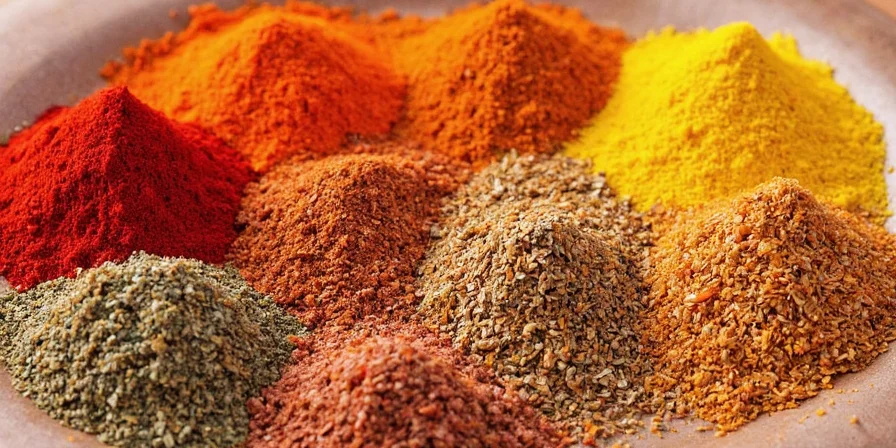Discover the 7 essential spices starting with 'S' that belong in every home cook's pantry. This practical guide reveals exactly what each spice is, how it tastes, and the most common ways to use it in everyday cooking - no confusing science jargon required. Whether you're wondering what sumac actually is or how to properly use saffron, you'll find clear, actionable answers here.
Unlike generic spice lists that just name ingredients, we've focused on what home cooks actually need to know: where to buy these spices, how much to use, common substitutions, and the simplest ways to incorporate them into weeknight meals. Save this guide for your next grocery trip or when a recipe calls for an unfamiliar 'S' spice.
Table of Contents
- Saffron – When to Splurge (and When Not To)
- Star Anise – Beyond Chinese Five-Spice
- Sumac – The Secret Ingredient for Brightness
- Sichuan Pepper – More Than Just Heat
- Sage – Perfect for Fall Cooking
- Sesame Seeds – Toasted vs. Raw
- Salt – Choosing the Right Type
- Comparison Chart: S-Spices Cheat Sheet
- 7 Practical Cooking Tips You'll Use Immediately
- Conclusion
- Frequently Asked Questions
Saffron – When to Splurge (and When Not To)

Saffron is the world's most expensive spice, made from the delicate stigmas of crocus flowers. It gives dishes a beautiful golden color and distinctive floral-honey flavor. Real saffron threads should be deep red with orange tips - avoid powdered saffron as it's often adulterated.
- What it tastes like: Earthy with subtle floral notes and a slight bitterness
- Best used in: Paella, risotto, baked goods, and seafood dishes
- How to use it: Crush a few threads and soak in 2 tbsp warm water or broth for 15 minutes before adding to your dish
- Substitute: Turmeric (¼ tsp) + pinch of paprika for color (won't replicate flavor)
- Storage: Keep in an airtight container away from light - lasts up to 6 months
Star Anise – Beyond Chinese Five-Spice

Star anise looks like a star-shaped pod and has a strong licorice flavor. It's one of the components in Chinese five-spice powder but works wonderfully on its own in braises and desserts. One whole star anise can flavor an entire pot of broth.
- What it tastes like: Sweet licorice with warm baking spice notes
- Best used in: Beef bourguignon, pho broth, poached pears, and mulled wine
- How to use it: Add whole during cooking and remove before serving (too hard to eat)
- Substitute: Anise seeds (use ½ tsp for each star) or fennel seeds
- Storage: Whole pods last up to 4 years in a sealed container
Sumac – The Secret Ingredient for Brightness

Sumac is a deep red powder made from dried berries with a tangy, lemony flavor. It's commonly used in Middle Eastern cooking but works beautifully as a finishing touch on many dishes. Look for it in the spice aisle or Middle Eastern markets.
- What it tastes like: Bright, citrusy with subtle berry notes (not spicy)
- Best used in: Hummus, grilled chicken, roasted vegetables, and salad dressings
- How to use it: Sprinkle on finished dishes like you would lemon juice
- Substitute: Lemon zest + a pinch of paprika for color
- Storage: Keep refrigerated - loses potency after 6 months
Sichuan Pepper – More Than Just Heat

Despite the name, Sichuan pepper isn't actually hot like chili peppers. It creates a tingling, numbing sensation that's characteristic of Sichuan cuisine. The best quality comes from China's Sichuan province, but substitutes are available.
- What it tastes like: Citrusy with floral notes and a distinctive tingling sensation
- Best used in: Mapo tofu, Kung Pao chicken, and dry-rubbed meats
- How to use it: Toast briefly in a dry pan, then grind just before use
- Substitute: Black pepper + pinch of coriander (won't replicate tingling effect)
- Storage: Buy whole and grind as needed - loses potency quickly when ground
Sage – Perfect for Fall Cooking

Sage is a hardy herb with soft, velvety leaves that have an earthy, slightly peppery flavor. Fresh sage is widely available, but dried works well too. It pairs perfectly with fall ingredients like squash, pork, and poultry.
- What it tastes like: Earthy with subtle pine and eucalyptus notes
- Best used in: Brown butter sauce, Thanksgiving stuffing, and pork dishes
- How to use it: Fry fresh leaves in butter until crisp for instant flavor boost
- Substitute: Marjoram or thyme (use half the amount)
- Storage: Fresh sage lasts 1-2 weeks wrapped in damp paper towel in fridge
Sesame Seeds – Toasted vs. Raw

Sesame seeds come in white (hulled) and black (unhulled) varieties. Toasting dramatically improves their nutty flavor. They're essential for Asian cooking but work well in baked goods and salads too.
- What it tastes like: Nutty and slightly sweet (toasted version is richer)
- Best used in: Stir-fries, sushi rolls, tahini, and bread coatings
- How to use it: Toast in dry pan over medium heat until golden (about 3 minutes)
- Substitute: Poppy seeds or sunflower seeds (different flavor profile)
- Storage: Keep toasted seeds in fridge for up to 3 months
Salt – Choosing the Right Type

Not all salts are created equal. Table salt, kosher salt, and sea salt have different crystal sizes that affect how they dissolve and taste. Using the right salt makes a noticeable difference in your cooking.
- What it tastes like: Varies by type (sea salt has subtle mineral notes)
- Best used in: All cooking and finishing (but choose type appropriately)
- How to use it: Use fine salt for baking, coarse for finishing dishes
- Types compared: Table salt (fine, iodized), Kosher salt (coarse, no iodine), Sea salt (varies, mineral notes)
- Storage: Keep in airtight container away from humidity
Comparison Chart: S-Spices Cheat Sheet
| Spice | Flavor Profile | Best Cooking Applications | Storage Life | Beginner Tip |
|---|---|---|---|---|
| Saffron | Floral, honey, subtle bitterness | Risotto, paella, sauces | 6 months (threads) | Soak in warm liquid before use |
| Star Anise | Licorice, warm baking spices | Braises, broths, desserts | 4 years (whole) | Add whole, remove before serving |
| Sumac | Citrusy, tangy, berry notes | Finishing dishes, dressings | 6 months (refrigerated) | Sprinkle like lemon juice |
| Sichuan Pepper | Citrusy, tingling sensation | Stir-fries, dry-rubbed meats | 3 months (ground) | Toast before grinding |
| Sage | Earthy, pine, eucalyptus | Pasta sauces, pork, stuffing | 1-2 weeks (fresh) | Fry in butter until crisp |
| Sesame Seeds | Nutty, slightly sweet | Stir-fries, sushi, breads | 3 months (toasted) | Toast for maximum flavor |
| Salt | Mineral notes vary by type | All cooking applications | Indefinite | Use coarse for finishing |
7 Practical Cooking Tips You'll Use Immediately

These simple techniques will help you use S-spices more effectively in everyday cooking:
- Don't waste saffron: Crush threads with the back of a spoon before soaking in warm liquid. A pinch (about 20 threads) is enough for 4 servings of rice.
- Revive old spices: Toast stale star anise or Sichuan pepper in a dry pan for 1 minute to refresh their flavor.
- Sumac shortcut: Mix sumac with olive oil and garlic for an instant Middle Eastern dressing.
- Sage butter hack: Fry 4-5 sage leaves in 2 tbsp butter until crisp, then pour over pasta or roasted vegetables.
- Perfect toasted sesame seeds: Spread on baking sheet and toast at 350°F for 5-7 minutes, stirring once.
- Salt smarter: When a recipe calls for "salt to taste," start with half what you think you need - you can always add more.
- Spice storage: Keep spices away from stove heat and sunlight to maintain freshness longer.
Conclusion

You don't need a neuroscience degree to use spices starting with 'S' effectively in your cooking. The most valuable approach is understanding each spice's basic flavor profile and how to incorporate it into everyday meals.
Start with just one new spice each week - try sprinkling sumac on your next salad or adding a star anise pod to your spaghetti sauce. These small experiments will build your confidence and help you discover which 'S' spices work best for your personal taste preferences. Remember that great home cooking is about simple techniques executed well, not complicated science.
Frequently Asked Questions
Where can I buy sumac if it's not in my grocery store?
Sumac is commonly found in Middle Eastern or Mediterranean markets. Many larger grocery chains now carry it in the spice aisle. You can also purchase it online from major spice retailers. Look for deep red powder without clumps - avoid anything that appears faded or brownish.
Is saffron worth the high price?
Yes, but only when used properly. A small amount (about 20 threads) is enough to flavor 4 servings of rice or sauce. Real saffron should have a floral aroma and create a golden-yellow color. If it doesn't noticeably color your dish or smells musty, it's likely low quality or fake. Store threads in an airtight container away from light.
How can I tell if my spices have gone bad?
Whole spices last longer than ground. To test freshness: rub a small amount between your fingers and smell it. If the aroma is weak or musty, it's time to replace. Ground spices typically last 6-12 months, whole spices 2-4 years. Store all spices in airtight containers away from heat and light for maximum shelf life.
Can I substitute dried sage for fresh?
Yes, but use one-third the amount of dried sage compared to fresh (1 tsp dried = 1 tbsp fresh). Dried sage works well in stuffing and spice rubs, while fresh is better for sauces where you want visible leaf pieces. Always add dried herbs earlier in cooking than fresh to allow time for rehydration.











 浙公网安备
33010002000092号
浙公网安备
33010002000092号 浙B2-20120091-4
浙B2-20120091-4